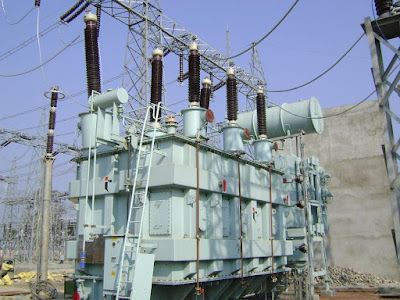Transformer Oil is basically an Insulating Oil. Insulating Oils or Transformer Oils are mineral electrical insulating oils processed from fractional distillation and treatment of crude petroleum.
An Insulating Oil must have the following properties:
1) Excellent dielectric properties resulting in minimum power loss.
2) High resistivity leading to better insulation values between windings.
3) High flash point and thermal stability facilitating reduction in evaporation losses.
4) Long life performance and excellent ageing characteristics, even under severe electrical stress.
5) Virtually devoid of corrosive sulphur, leading to enhanced stability and protection against corrosion.
6) Wider operating temperature range, resulting from higher flash and lower pour point.
7) Available in a wide range of grades to fit every requirement and meeting every possible specification.
Insulating Oil when used in a Transformer is popularly known as Transformer Oil. The Oil in Transformer serves the following purposes:
1) Transformer Oil provides the liquid insulation in between the windings and other conductive parts of Transformer.
2) It acts as a cooling medium.
3) It preserves the Core and the winding of the Transformer as the Transformer Core and winding remain immersed in the Oil.
4) The most important role played by the Transformer Oil is to protect the interaction of atmospheric oxygen and the cellulose made paper insulation of the winding. In this way Transformer Oil prevents the oxidation of cellulose made paper insulation of the winding.
Thus we observe that Transformer Oil has great importance and it does not only acts as a cooling medium rather it does many other things to keep Transformer healthy.
Types of Transformer Oil:
There are two types of Transformer Oil, Naphthenic and Paraffinic based Transformer Oils. A comparison between the Naphthenic and Paraffinic Transformer Oil is listed below.
|
Sr. No.
|
Naphthenic Oil
|
Paraffinic Oil
|
|
1)
|
Mineral insulating oil derived from special crudes containg very low n-paraffin i.e. wax.
|
Mineral insulating oil derived from special crudes containg substantial amount of n-paraffin i.e. wax.
|
|
2)
|
The pour point of Naphthenic Oil is less than the Paraffinic Oil as the wax content is low.
|
The pour point of Paraffinic Oil is more than the Naphthenic Oil as the wax content is high.
|
|
3)
|
Boiling point of Naphthenic Oil is around 425 °C.
|
Boiling point of Paraffinic Oil is around 530 °C.
|
|
4)
|
Naphthenic Oils are more readily oxidized than Paraffinic Oils.
|
Oxidation of Paraffinic Oil is less.
|
|
5)
|
Oxidation products of Naphthenic Oils are soluble in the oil.
|
Oxidation products of Paraffinic Oils are insoluble in the oil.
|
|
6)
|
The oxidation of paraffin-based crudes produces an insoluble sludge, which increases the viscosity. It results in reduced heat transfer capabilities, overheating and reduced service life.
|
Although naphthenic oils are more readily oxidized than paraffinic but the oxidation products are soluble in the oil results in a reduction of problem.
|
|
7)
|
Naphthenic oils contain aromatic compounds which remain fluid at comparatively low temperatures such as -40°C.
|
–
|
In India, Naphthenic based Transformer oil is used in spite of its high pour point. High Pour point does not cause any problem because of hot climate of India. As Naphthenic based oil is easily available in India and India has quite warm Temperature, therefore Naphthenic based oil is used.
Moisture content in Transformer Oil is highly undesirable as it affects the dielectric properties of oil. The water content in oil also affects the paper insulation of the core and winding of Transformer.
Paper is highly hygroscopic in nature. Paper absorbs maximum amount of water from oil which affects paper insulation property as well as reduced its life. But in loaded transformer, oil becomes hot, hence the solubility of water in oil increases as a result the paper releases water and increases the water content in Transformer Oil.
At site, two types of tests are conducted. One is BDV Test i.e. Break Down Voltage Test and moisture content test. Moisture content in oil is measured as ppm (parts per million). Normally the BDV value for Transformer oil shall be more than 70 kV/cm and moisture content shall be less than 10 ppm.

Thank you so much, friends sharing this information. Your giving information is essential or meaningful.This is the wonderful article.